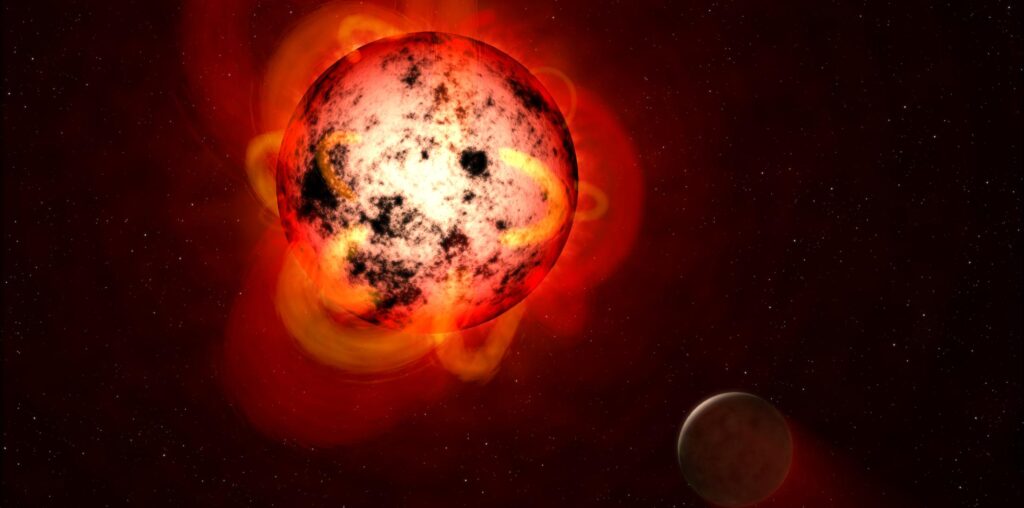
NASA / ESA / STScI / G. Bacon
Which of the nearly 6,000 known exoplanets have atmospheres? With help from the James Webb Space Telescope (JWST), astronomers are inching closer to an answer, and new observations of a super-Earth planet around a low-mass star help to define the dividing line between planets with atmospheres and planets without.
How to Find an Atmosphere
With the number of known exoplanets growing steadily larger, a major challenge for astronomers is deciding how to allocate limited telescope time to study these planets further. Rocky planets with atmospheres make promising targets, but it’s not obvious which exoplanets should have atmospheres. Taking cues from the planets in our solar system and the subset of exoplanets that have been studied in detail, researchers have defined the concept of the cosmic shoreline, which separates planets with atmospheres from planets without on the basis of escape velocity — related to a planet’s mass and size — and the amount of starlight the planet receives.
While simple in concept, charting the cosmic shoreline is difficult, especially for planets circling M dwarfs: the smallest, coolest, and most common type of star. M dwarfs are notorious for their extreme space weather, which can strip away a planet’s atmosphere over billions of years. To learn more about the exact position of the cosmic shoreline and to guide our observations of M-dwarf exoplanets, researchers must search for atmospheres on planets subjected to the fierce conditions of an M-dwarf host star.
A Promising Planet
Discovered by the Transiting Exoplanet Survey Satellite (TESS), Gliese 486b (Gl 486b or GJ 486b) is a super-Earth exoplanet with a radius of 1.29 Earth radii and a mass of 2.77 Earth masses. Its host star is a 6.6-billion-year-old M dwarf that is known to explode with high-energy stellar flares. At just 26 light-years away, Gl 486b is one of the closest transiting terrestrial exoplanets known.
Last year, researchers published an investigation of Gl 486b’s atmosphere, finding that JWST transmission spectra suggested either a water-rich atmosphere or no atmosphere at all. If there is no atmosphere, the observed signal from water vapor must have come from cool regions on the host star rather than from the planet’s atmosphere.

AAS Nova / Kerry Hensley
Recently, Megan Weiner Mansfield (Steward Observatory; Arizona State University) and collaborators used JWST to collect secondary eclipse observations of Gl 486b, watching as the planet passed behind its host star. Secondary eclipse observations show the thermal glow of the planet and starlight reflected from its surface. Coupling the secondary eclipse observations with previously collected JWST and TESS data, the team found that the planet’s dayside temperature is a scorching 865K. This high temperature suggests that Gl 486b has either a thin atmosphere or no atmosphere at all, since a thick atmosphere would redistribute the heat and lower the dayside temperature.
Atmosphere Likely Lacking

Mansfield et al. / Astrophysical Journal Letters 2024
With these constraints in hand, Mansfield’s team used forward modeling to explore the types of atmospheres that could be present. They found that a planet with no atmosphere provided the best fit to the data, but a thin atmosphere was also acceptable, as long as it contained only a small amount of water or carbon dioxide.
Given the realities of 6.6 billion years spent around an active M-dwarf star, the team concluded that Gl 486b is unlikely to have an atmosphere. In addition to weighing in on the likelihood of Gl 486b having a water-rich atmosphere, the team also achieved the most precise measurement yet of a planet’s dayside temperature, constraining the temperature to within just 14K.

em>Mansfield et al. / Astrophysical Journal Letters 2024
Overall, these findings help to define the location of the cosmic shoreline and suggest that in order to find M-dwarf exoplanets that have retained their atmospheres, exoplanet atmosphere hunters must probe more massive or less strongly irradiated worlds
Citation
“No Thick Atmosphere on the Terrestrial Exoplanet Gl 486b,” Megan Weiner Mansfield et al 2024 ApJL 975 L22. doi:10.3847/2041-8213/ad8161
This post originally appeared on AAS Nova, which features research highlights from the journals of the American Astronomical Society.

